Facts About Paper: How Paper Affects the Environment
06/18/2023

At a Glance: Paper Statistics Uncovered
- Global paper use has spiked by 400% in the last 40 years, with the average American consuming over 700 pounds of paper annually, the highest per capita worldwide.
- Astonishingly, every year sees over 24 billion newspapers, 350 million magazines, and 2 billion books published in the US alone.
- The pulp and paper industry is the fifth largest energy consumer globally, accounting for 4% of all the world's energy use.
- Paper recycling efforts are considerable: in the US alone, over 50 million tons of paper were recycled in 2021, matching the highest rate ever achieved at 68%.
- Despite recycling efforts, paper still contributes significantly to global waste, with 40% of all waste in the United States being paper-based.
- Paper production has major environmental impacts, with the industry in the U.S. and Canada alone responsible for roughly 10% of the release of fine particulate matter, a harmful air pollutant.
These facts barely scratch the surface of the enormous impact of our paper consumption habits. Read on to uncover the full picture and find out what you can do to make a difference.
What does paper cost? About a penny per sheet, give or take.
But what is the environmental cost of paper use and production? What impact has the paper consumption on the environment we live in?
Sadly, the environment pays the highest price of all for our love affair with paper.
Let’s look at some paper facts and stats below to see what the numbers say about this.
General Stats and Facts About Paper (Consumption & Production)
Paper Usage Statistics
- Global paper use has increased by 400% in the last 40 years.
- Average person in the US uses more than 700 pounds of paper every year. That’s the highest paper usage figure per capita worldwide.
- In the last 20 years, the usage of paper products in the US reached 208 million tons (up from 92 million), which is a growth of 126%.
- Every year more than 24 billion newspapers, 350 million magazines and 2 billion books are published in the US.
- This is how per capita paper consumption (by region) looked on the World map not so long ago, in 2016:
Global Paper Consumption Statistics
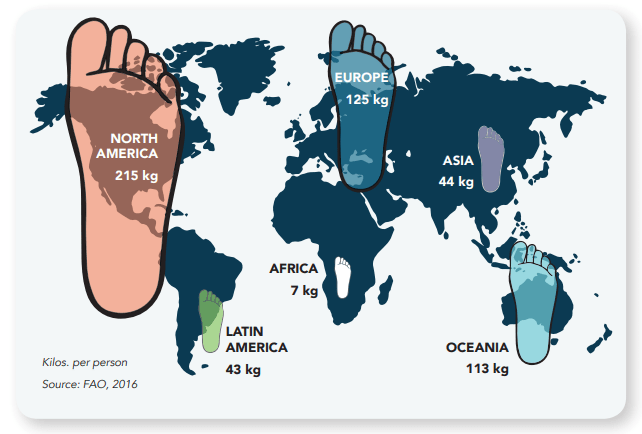
Source: EPN
- America uses about 30% of the global paper supply, although we account for only 4.25% of the world’s population.
- To meet the global demand paper production volumes currently exceed 300 million metric tons per year. (Perhaps more people should switch to ebooks?)
- This number is over 400 million when we look at the combined paper and cardboard data:
Global Paper and Cardboard Production Volumes 2021 - 2032 (in million metric tons)

Source: Statista
Paper Production by Country on 2010 and 2021
(in 1,000 metric tons)
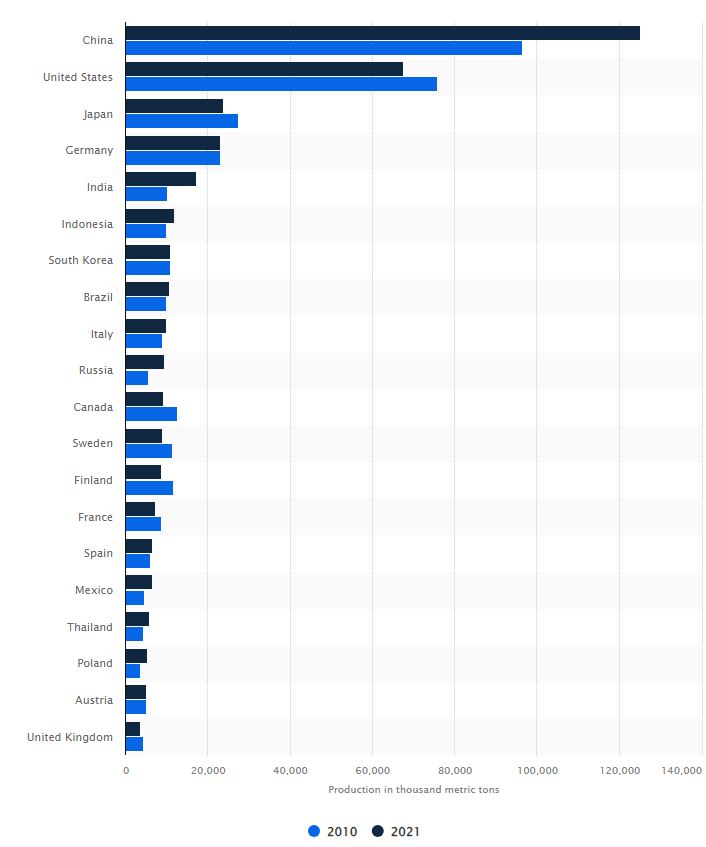
Source: Statista
- Interestingly, global paper consumption statistics show printing is not the main paper consumption category. Packaging is:
Global paper consumption (by paper category, in tonnes)
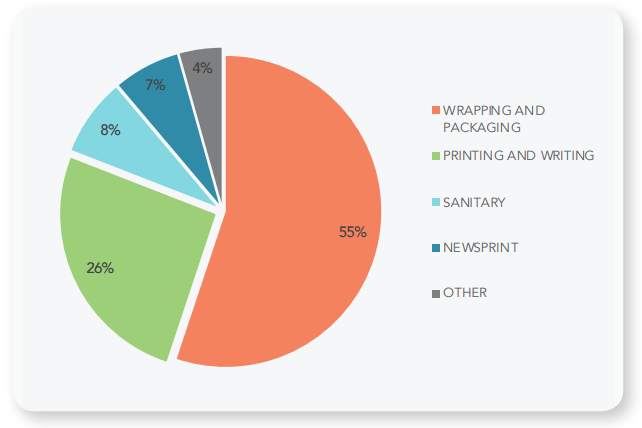
- Production volumes when grouped by type look similar to the graph on consumption above:
Paper production volumes from 2010 to 2021 by type (Global production in 1,000 metric tons)
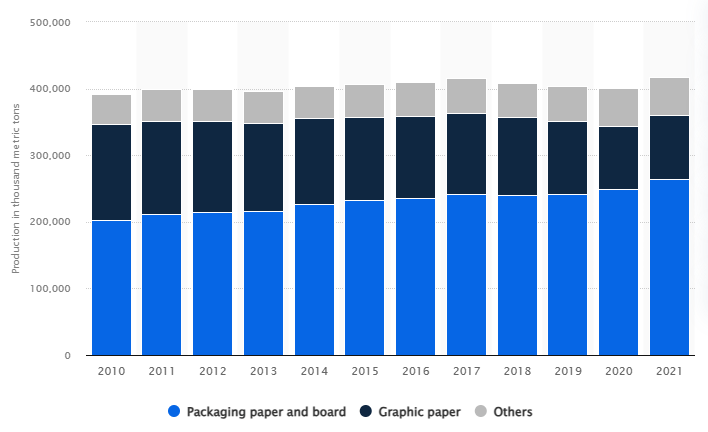
Source: Statista
- Likewise, the pulp and paper industry is the fifth largest consumer of energy, accounting for 4% of all the world’s energy use.
- Today, approximately 50% of the world’s industrial logging goes into making paper.
- 422 million metric tons of paper products were produced globally in 2018.
- Every 10 minutes enough toilet paper is used globally to circle the earth.
Paper Recycling Facts And Statistics
- We also recycle a lot. Papermakers in the US every day recycle enough paper to fill a fifteen mile long train of boxcars.
- One-third of papermaking materials come from recycled paper in the US.
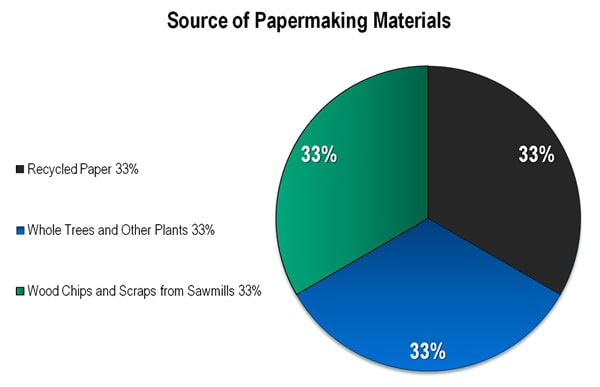
Source: EPA/TAPPI
- The American Forest & Paper Association (AF&PA) reported that over 50 million tons of paper were recycled in 2021 in the US. The paper recycling rate reached 68%, matching the highest rate ever achieved.
☝ Note: In 2018, the rate of recycling was already 68.2% (46.0 million tons), 2.3% more than in 2017 and 25.4% more compared to 2000 (42.8%).
- 500,000 trees must be logged to produce Sunday newspapers around the world. 250 million trees could be saved if all newspapers were reprinted on recycled paper.
- Australian newspapers are made with 40% recycled content.
- About 30 percent of newsprint made by Australia's only manufacturer, Norske Skog, is recycled fiber.
- Generally, Australia doing great in newspaper recycling:
Newspaper Recycling and Recovery in Australia between 1990 and 2020
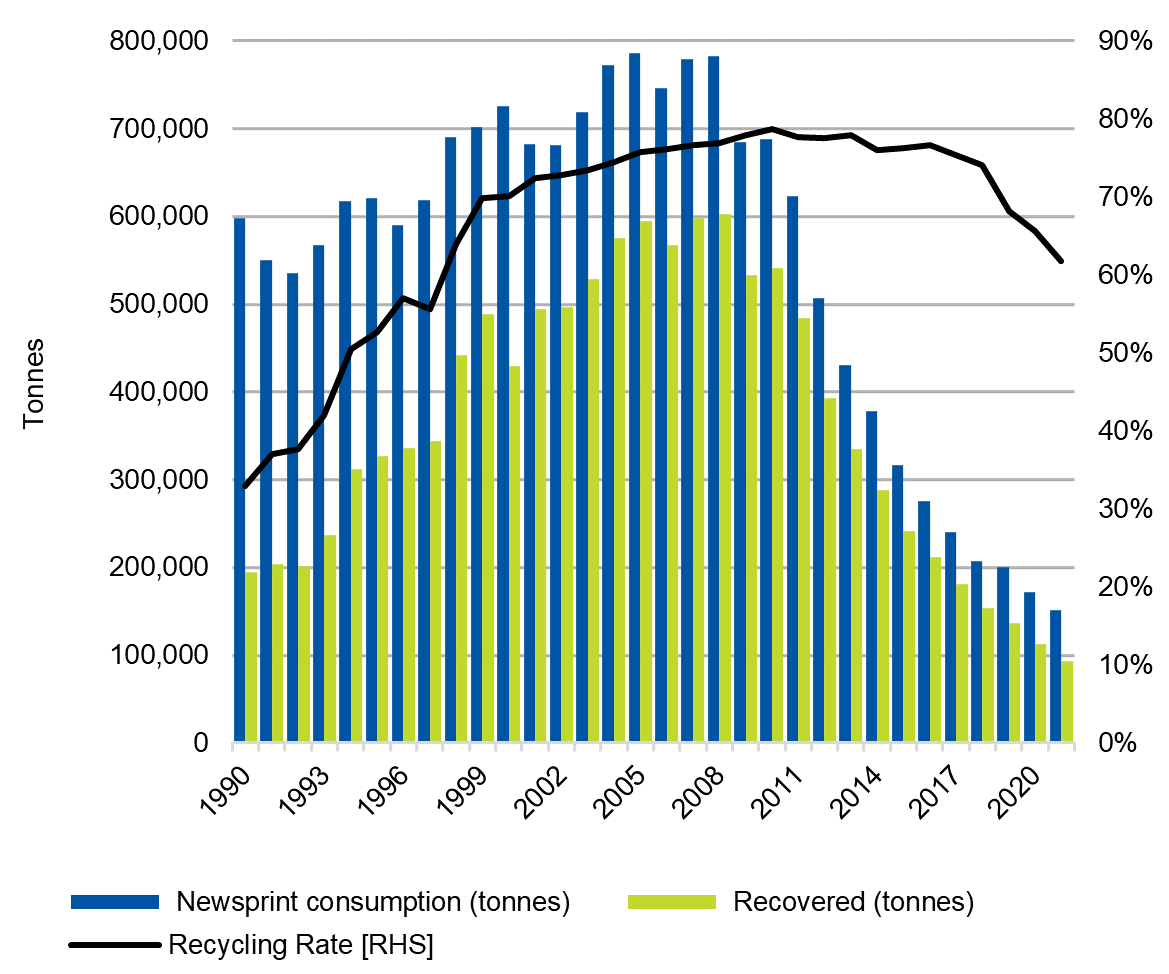
- In 2021, UK households produced 5.4 million metric tons of paper and cardboard packaging. Out of this, about 3.8 million metric tons were recycled, resulting in a recycling rate of approximately 70%.
- Current paper recycling rate in the EU is about 74%. Target rate for 2030 is 76%.
Paper Recycling in Europe from 1991 to 2020
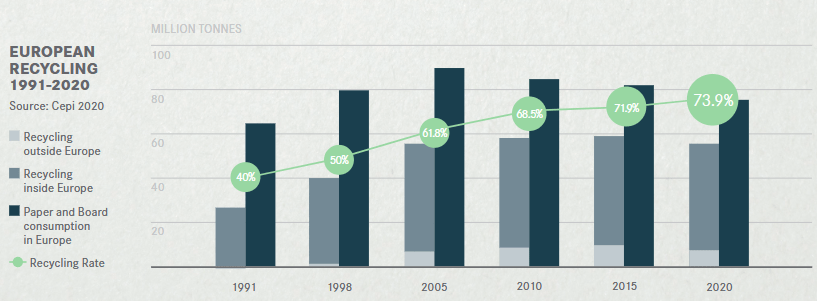
Some Interesting Recycling Paper Facts:
Here is how using recycled paper can help the environment:
- Recycled paper production results in 40% fewer greenhouse gases.
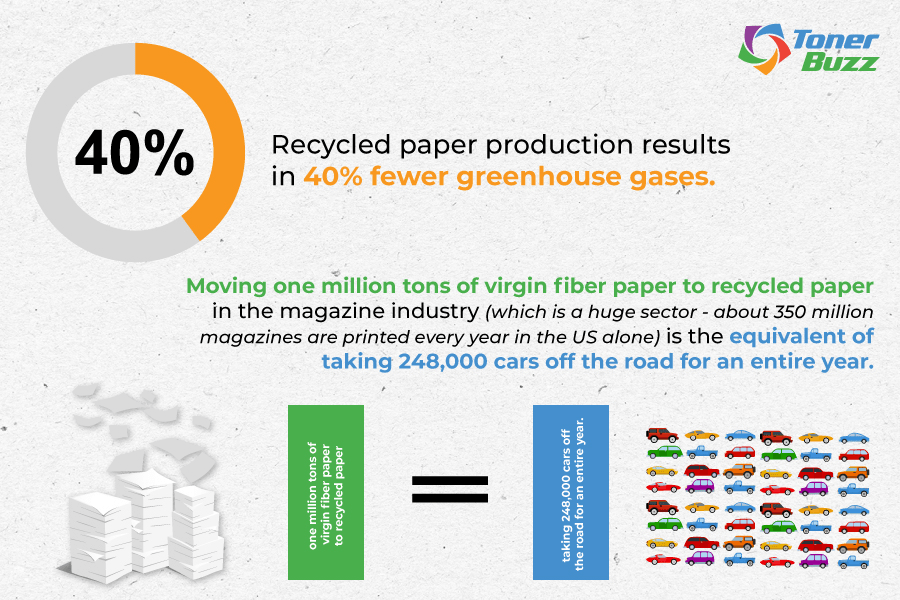
Moving one million tons of virgin fiber paper to recycled paper in the magazine industry (which is a huge sector - about 350 million magazines are printed every year in the US alone) is the equivalent of taking 248,000 cars off the road for an entire year.
- Recycled paper requires 26% less energy to produce.
- Every tonne of recycled paper usually saves enough energy to power a house for a whole year!
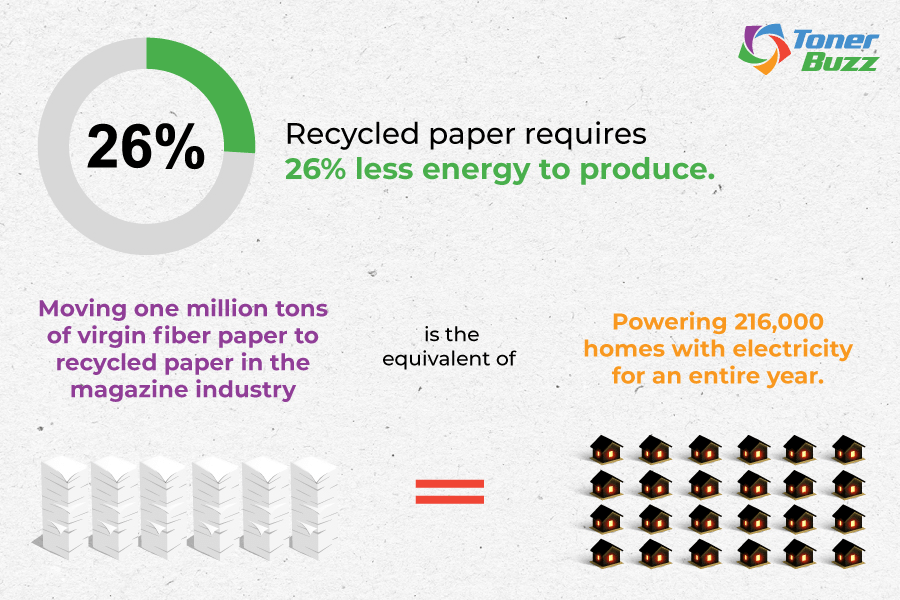
Moving one million tons of virgin fiber paper to recycled paper in the magazine industry is the equivalent of powering 216,000 homes with electricity for an entire year.
- Production of the recycled paper creates 43% less waste water.
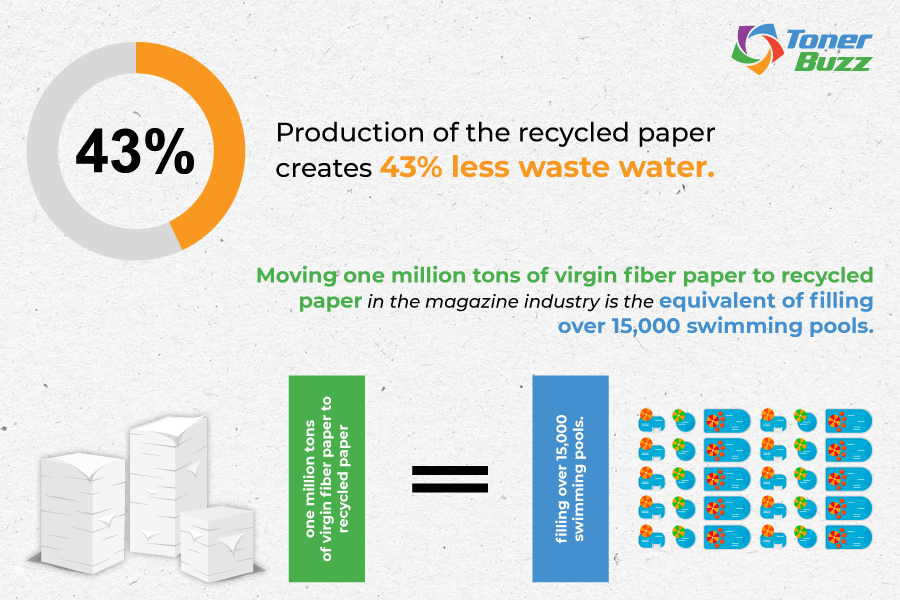
Moving one million tons of virgin fiber paper to recycled paper in the magazine industry is the equivalent of filling over 15,000 swimming pools.
- On average the recycled newspaper comes back as a newspaper again in just 7 days.
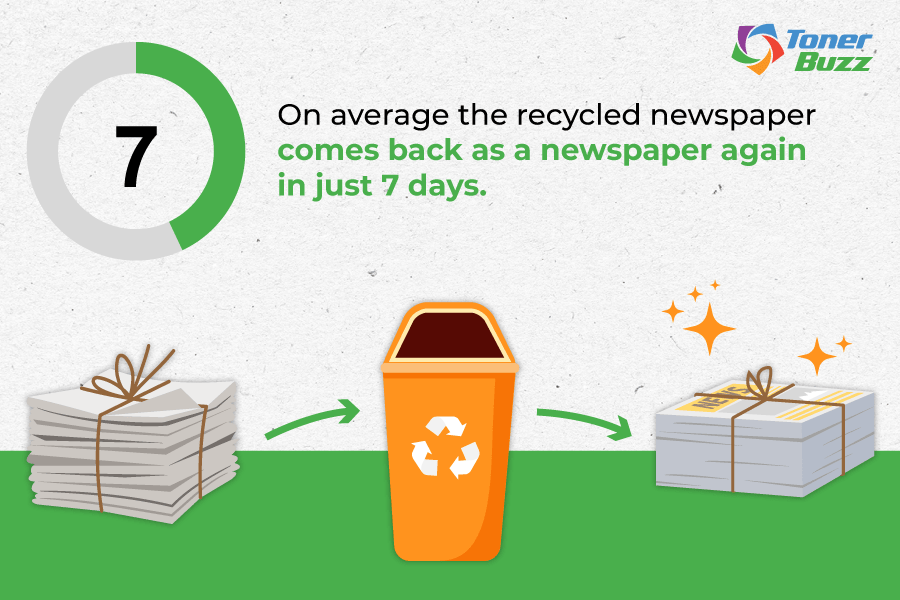
- Recycled paper production leads to 73% less air pollution compared to standard paper production.
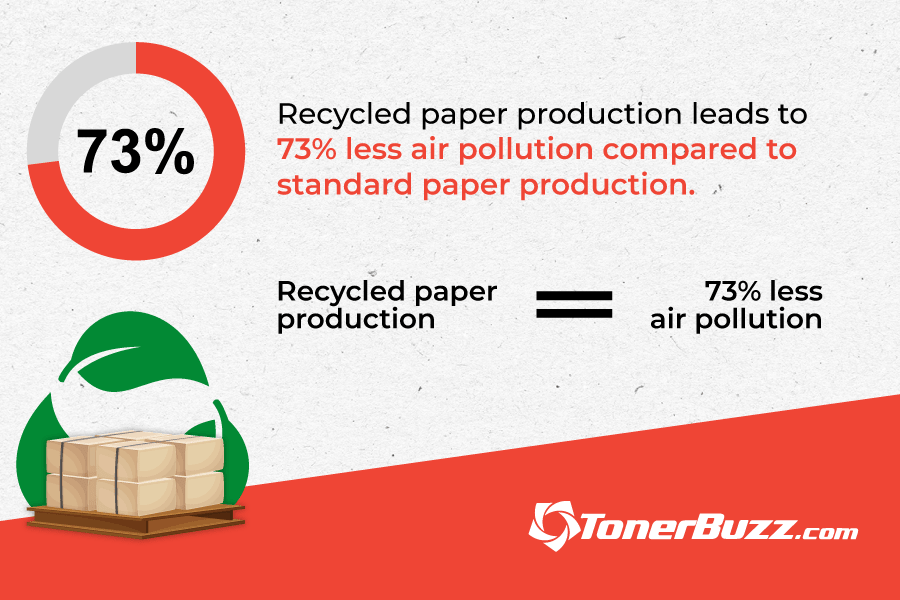
Paper Towels and Paper Towel Waste
- In 2020, the global paper towels market was valued at $13,900 million and is anticipated to reach $19,290 million by the end of 2027.
- Global paper towels usage transforms into 254 millions of trash every single year (3,000 tons of waste daily which is the equivalent of 51,000 trees cut).
- The US household paper market was worth $6.2 billion in 2020 and is projected to grow at an annual rate of 4.6% between 2022 and 2028.
US Household Paper Market 2019-2028

- The number of Americans using paper towels was recorded at 321.87 million in 2020. It is estimated that this figure will rise to 331.16 million by 2024.
- Just three saved paper towel rolls per household in the US each year could lead to 120,000 tons less waste and save $4.1 million in waste processing costs.
Paper in Business
- Most of the businesses are still primarily paper-dependent. The fire or flood that results in a massive loss of paper-based documentation would make more than 70% of today’s businesses fail in just three weeks.
- Currently, companies in the US spend over 120 billion dollars per year on printed forms.
- Most of these print forms become outdated in just three months.
- In general, approximately 45% (that’s almost half!) of all pages printed in the offices eventually end up in the trash.
- Moreover, on average companies completely lose around 7.5% of all their paper documentation.
- And then they spend around $122 for finding the lost document.
- On average companies in the US spend around 4 weeks every year trying to find lost documents.
- Nevertheless, there are now more than 4 trillion paper documents in the US.
- We also copy a lot: a typical document gets copied 9-11 times.
- Altogether paper consumption in business keeps growing. Paper use in an average business grows by 22% a year, meaning paper costs double every 3.3 years.
- The average office worker in the US goes through roughly 10,000 sheets of paper each year.
- The maintenance of every 12 filing cabinets usually requires an additional employee.
- Employees spend 30-40% of their time looking for information locked in email and filing cabinets – average filing expenses are about $20 per month.
- The capacity of a four-drawer filing cabinet is approximately 11,000 documents. It also uses 9 square feet of space, and costs about $1,500 per year.
- It’s estimated that each misfiled document in a filing cabinet costs a company $125. A lost document costs between $350-700. Large companies can lose a document every 12 seconds!
Effects of Paper Consumption on the Environment
Paper Industry Statistics:
- Pulp and paper is the third-largest air, water, and land polluter among all industries in both Canada and the US. The pulp and paper industry releases over 100 million kilograms of toxic pollution every year.
- The paper industry in the U.S. and Canada is responsible for roughly 10% of the release of fine particulate matter, airborne particles linked to respiratory system damage and serious health issues.
- Paper manufacturing produces nitrogen oxides and sulfur oxides, which contribute to acid rain, and carbon dioxide, a greenhouse gas that contributes to climate change.
- Generally, 66% of paper manufacturing waste in the United States is released into the air, 10% is released into the water, and 24% of paper manufacturing waste winds up in landfills.
- The U.S. cuts down approximately 36 million trees each year to produce paper products.
- At the same time, approximately 1 billion trees worth of paper are thrown away every year in the US.
- Globally, around 15 billion trees are cut down each year in the World, and the biggest portion of the paper created from these trees are going towards books and textbooks.
- In 2006, approximately 6.5 million trees were cut down to make 16 billion coffee cups. This used 4 billion gallons of water and generated 253 million pounds of waste.
- On average Americans use 7 trees per person a year in paper, wood, and other products made from trees. This amounts to approximately 2 billion trees per year!
- An estimated 18 million acres of forest are lost each year to paper production. That’s the equivalent of 20 football fields every minute.
- To meet the yearly paper demand in the UK, you need a forest the size of the whole Wales!
How Much Paper Comes From One Tree?
A 45-foot pine tree with an 8” diameter will produce approximately 10,000 sheets of paper.
Paper Waste Facts and Statistics:
- In 2018, paper constituted 23.05% (up from 16% or 26 million tons in 2009) of municipal solid waste in U.S.
Total MSW Generated by Material in the US (2018)
292.4 million tons
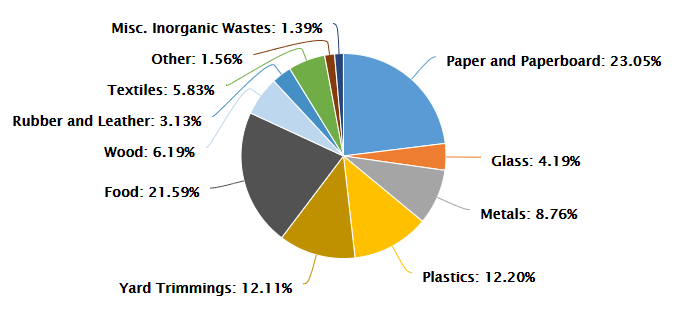
Source: EPA
- The share of the paper in municipal solid waste by weight is 35%.
- Generally, 40% of all waste in the United States — 71.6 million tons — is paper-based.
- The average US household throws away 13,000 separate pieces of paper each year. Most are packaging and junk mail.
- On a global scale the share of paper and cardboard in global waste composition is 17%:
Global Waste Composition (by category percentage)
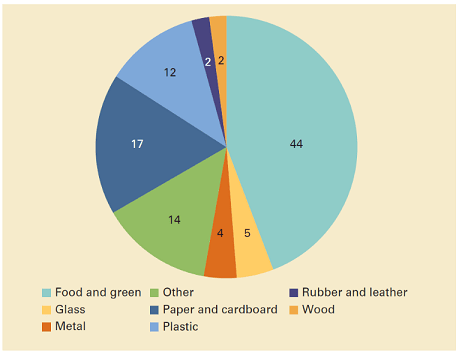
Source: World Bank
- During the holiday season, the United States generates 6 million tons of paper waste.
- 85 million tons of paper-based trash is generated in the United States each year.
- 70% of office waste in the US is paper.
- Junk mail generates over 2 million tons of landfill waste each year in the US (over 4 million tons of junk mail gets generated each year and more than 50% of it eventually ends up in landfills).
What we can do about the negative effects of paper?
Here are the main things we can do to mitigate the negative effect of paper consumption:
- Use less paper. Don’t use paper when it is not necessary.
- Reuse paper when possible.
- Recycle and try to use recycled paper whenever possible.
- Switch to eco-friendly paper alternatives whenever possible.
- Better forest management
Let’s take a closer look at those things.
➜ Use Less Paper
Probably the best way to prevent the negative effects of paper consumption over the environment is to use less paper. This however does not mean that you need to completely stop using paper (that would probably be a good thing, but not always possible).
Here are some smart things you can do:
- If your business produces a lot of documents you would benefit from using a software-based Document Management System. You’ll save a bunch on paper cost, too!
- Print on both sides of the paper (duplex printing) when printing on one side is not necessary. This is a simple way of reducing paper usage (and costs) by 50%.
- Use thin paper. This can help to save up to 20% of paper both in usage and cost.
- Instead of taking paper notes, try a white board.
- Think before you print. Do you really need to print this? Do you need to print the whole document, or could you get by with only a page or two?
- Check your document carefully for errors before printing. Re-printing wastes paper and money.
- Use original cartridges to prevent reprints. Non-original cartridges may seem cheaper but can cause print issues, leading to reprints and wasted paper. In contrast, original ones help prevent printing errors that lead to reprints. While original cartridges can be expensive, you can find cost-effective solutions. For example, you can choose high-yield cartridges to lower the cost per page or opt for sets like HP 414A 4-Pack, HP 414X 4-Pack or HP 206X 4-Pack instead of buying individual cartridges, as they are usually more affordable.
- Use cloth napkins instead of paper.
- Use rags instead of paper towels.
➜ Reuse Paper
There are hundreds if not thousands of ways to reuse paper like crafting with old paper, using old paper (instead of a new one) for your home or office needs when possible and other similar things.
The main thing to remember here is to keep the paper you do not need anymore and use it as needed for different purposes. This will help you to avoid using new paper everytime you need to do something with paper.
➜ Use Recycled Paper
Consider using recycled printer paper. Your prints may not look as sharp, but you’ll save some trees.
We described above how recycled paper helps the environment. You may want to check that section again to see how you can get involved and what exactly you can do.
➜ Paper Alternatives
Want to help the environment? Use eco-friendly paper alternatives!
While still relatively rare, treeless paper is growing in popularity. While many companies in India and China produce dead-tree alternatives, you’ll need to hunt around to find suppliers in the United States, Canada, and Europe.
- There’s a place in Thailand where you can get paper made from elephant dung! Find out more at PooPooPaper.com.
- TreeZero makes sheets of paper from sugarcane waste fiber.
- Paper companies already produce eco-friendly sheets made from kenaf, bamboo, cotton, and other plants. There is also a “stone paper” made from calcium carbonate bonded with high-density polyethylene, for use in stationary, books, posters, and packaging.
- Japanese manufacturer Teijin has developed a waterproof paper made from recycled plastic.
- Specialty producers can also make paper from mango leaves, the waste bark of a banana tree, straw, coconut, hemp, and jute.
While none of the above specialty papers have made it to cost-effective mainstream use, they could if the demand were there. So, save a tree and use treeless paper!
➜ Large-scale solutions
One more solution to paper waste lies in sustainable forest management.
For example, plant four fast-growing trees for every one forested. In Canada, about 21% of the trees cut down are used to make paper and cardboard. In the United States, that number is closer to 35%. (Sadly, as we mentioned above, paper and cardboard make up 26% of landfill waste in America.)
But, through proper sustainable forest and logging management, the environmental threat of deforestation can be greatly reduced.
Further Reading:
Sources
European Declaration on Paper Recycling 2021-2030
The State of the Global Paper Industry 2018 (EPA)
Facts and Figures about Materials, Waste and Recycling - National Overview (EPA)
Facts and Figures about Materials, Waste and Recycling - Paper and Paperboard (EPA)
Trends in Solid Waste Management (The World Bank)
Production volume of paper and cardboard worldwide from 2008 to 2018
Global paper production volume from 2008 to 2018 by type
Global consumption of paper and cardboard 2007 to 2018
2015 Toxics Release Inventory National Analysis Report
American Forest & Paper Association
https://ribble-pack.co.uk/blog/much-paper-comes-on...
Paper and Cardboard Fact Sheet
https://www.smh.com.au/environment/the-shady-side-...
https://industryedge.com.au/australias-world-class...




